

 Vol. 39 (# 02) Year 2018. Page 9
Vol. 39 (# 02) Year 2018. Page 9
Natalya ZAVYALOVA 1
Received: 16/12/2017 • Approved: 22/12/2017
ABSTRACT: New international agendas for Russia are becoming a key instrument in shaping multi-polar global future. There is much evidence that China plays a pivotal role in Russian foreign affairs. Socio-cultural acquisition of Chinese heritage in Russia comes hand-in-hand with learning the Chinese language. In order to successfully meet new targets Russian teenagers today have to acquire fluent Chinese competence. The key factor to meet this ambitious goal is motivation which has to be developed by new teaching principles. The paper focuses on innovative computer-based technologies for teaching Chinese. The main stress is laid on the analysis of corpus frequencies and audio annotation of recorded speech. One more aspect of the paper is the interaction with students outside the central region of Russia. The article features a teaching experiment with school students from Yekaterinburg, Ural region. The results of the experiment showed that the introduction of hands-on corpus-analysis experience made it possible for students to share their feeling of achievement, become more autonomous in learning and flexible with daily studying routines. Though the experiment was conducted with a small group of 10 learners – which is a common practice for Chinese learning groups in cities outside the central region – the author believes that the results are suggestive enough for a large-scale practice of introducing modern linguistics’ methods to a school classroom. |
RESUMEN: Las nuevas agendas internacionales para Rusia se están convirtiendo en un instrumento clave para dar forma al futuro global multipolar. Hay mucha evidencia de que China desempeña un papel fundamental en los asuntos exteriores rusos. La adquisición socio-cultural de la herencia China en Rusia viene de la mano con el aprendizaje del idioma chino. Con el fin de cumplir con éxito los nuevos objetivos de los adolescentes rusos hoy en día tienen que adquirir una competencia China fluida. El factor clave para cumplir con este ambicioso objetivo es la motivación que debe ser desarrollada por los nuevos principios docentes. El papel se centra en tecnologías informáticas innovadoras para la enseñanza de chino. La tensión principal se pone en el análisis de las frecuencias del corpus y de la anotación audio del discurso registrado. Un aspecto más del documento es la interacción con los estudiantes fuera de la región central de Rusia. El artículo incluye un experimento de enseñanza con estudiantes de la escuela de Yekaterinburg, región de Ural. Los resultados del experimento demostraron que la introducción de experiencias prácticas de análisis de Corpus hizo posible que los estudiantes compartieran su sentimiento de logro, se convirtieran en más autónomos en el aprendizaje y flexibles con las rutinas diarias de estudio. Aunque el experimento se llevó a cabo con un pequeño grupo de 10 estudiantes – que es una práctica común para grupos de aprendizaje chinos en ciudades fuera de la región central – el autor cree que los resultados son lo suficientemente sugestivos para una práctica a gran escala de introducir métodos modernos de la lingüística a un aula de escuela. |
The paper describes the practice of teaching Chinese as the third foreign language to non-Chinese background beginners. The imperative of the time suggests that Russia should become a country with a better integration with and within BRICS community, both from economic and social perspectives. The key bottleneck, jeopardizing the well-grounded establishment of learning Chinese in Russia, especially in the regions outside Moscow and St. Petersburg, namely Yekaterinburg in Sverdlovsk region, is the lack of motivation among Russian middle school students. One should bear in mind the long history of mantras, underlining the challenges of learning Chinese for Russian students, fixed in Russian traditional proverbs and sayings. This old false stereotype is eloquently discussed in the article in ‘BRICS Business Magazine’ by M.Fedotova, first Vice-President of the Russian-Asian Union of Industrialists and Entrepreneurs (RASPP) which she entitled as follows: ‘Russian Sayings: It’s All Chinese to Me’ (Fedotova, 2015).
However, the information retrieval, performed by Serelex (Panchenko et al., 2013) – the system which finds semantically related words in Wikipedia articles – testifies to the fact that Russia comes fourth in the Chinese system of priorities (see Figure1).
Figure 1
Serelex graph of the request form ‘China’ (Serelex search system, 2015)
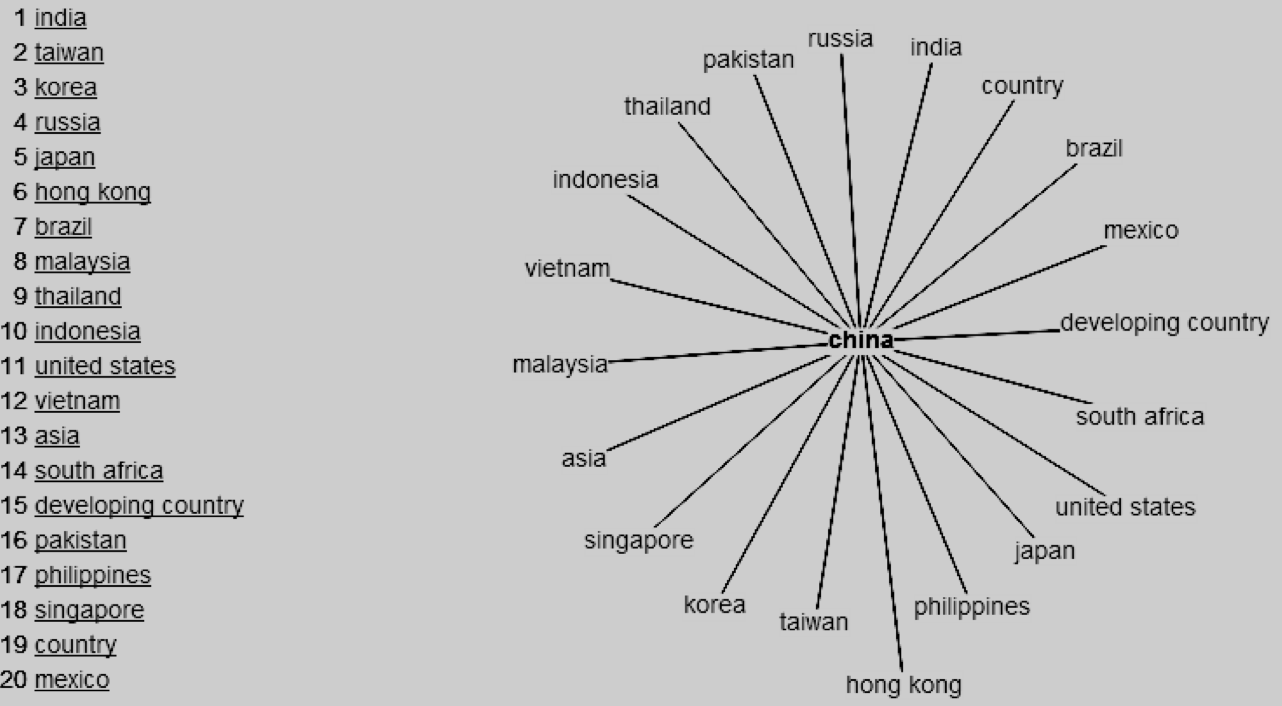
The strategic value and utility of the Chinese language has been continuously rising in Russia over the last decade. In order to support the learning of Chinese among Russian students Russian government has a strong commitment to establish State Unified Exam in Chinese by the year 2016. Thus, the problem of continuous motivation to learn this language and get a high school leaving exam mark is of vital importance for many students. This problem is organically connected with the ideas of socio-cultural narratives, actualized in learning (Zavyalova, 2014).
This paper targets at describing key concepts of motivation development in the sphere of learning Chinese. From technological prospective, we are focused on modern technologies, facilitating learning of Chinese to Russian teenagers, which makes language acquisition free and accessible to everyone. Socially speaking, we concentrate on such aspects as equity, social justice, and multicultural education in Russia.
In this paper, we argue that in order to maintain a stable motivation to the Chinese language acquisition we have to introduce a new type of educational philosophy, based on cut-of-the-edge technological innovations. It entails the latest linguistics’ tools and technologies in every day classroom. From the Russian layman’s perspective the usage of mobile phones and PSs is a stable regular practice which has to be adopted for major classroom activities. To put it in the words of Cheng Aimin, modern teachers of Chinese are obliged ‘to fully utilize modern information technology, multimedia and internet techniques in combining paper writing, audio-visual and network features, and even game activities into an integrated multi-dimensional text, thus making teaching and learning Chinese easier and more interesting’(Cheng, 2015). On top of that we propose the idea that even the latest data mining and information extraction tools have to be utilized for the purpose of Chinese instruction in middle school. This new philosophy offers a wide variety of alternative tasks and practices.
This paper builds on and contributes to a relatively new research field – teaching Chinese as a second foreign language outside mainland China, in Russia namely. The subject of our concern is the strategy to instill and enhance the motivation among Russian teenagers to study Chinese. Ruan et al. rightfully assume that ‘motivating learners to continue learning the language and encouraging active participation may be more important than developing their linguistic accuracy and fluency in the given context.’ This paper zooms on a unique blend of traditional and innovative approaches in teaching Chinese. The main idea of this mixture is the students’ introduction to the latest methods of frequency calculations and annotation of audio in Chinese class. In the first section of this paper we elaborate on a 3-stage experiment, each stage of which introduces a new format of innovative language learning, pertaining to learning motivation. In the remainder of the article we are concentrated on the significance of a fluent command of Chinese for the Ural region in general and Yekaterinburg in particular.
New electronic educational philosophy receives more and more attention on a global scale. However, scholars rightfully suggest that on-line learning is not a magic solution of the eternal motivation problem. In their study Cai and Zhu managed to pinpoint ‘specific motivating and demotivating features of the online project’. Nevertheless, our objective in teaching Chinese was not to give old school books’ format but to show fresh alternative ways of the Chinese language acquisition, staying aloof from pen-and-paper tasks. Thus, many tasks were set on-line on our page (Figure2) on the open platform Padlet Marks (Chinese Class, 2015). The information about Padlet Marks, the product of Wallwisher, Inc. is available at their main page (Padlet, 2015).
Figure 2
The on-line page for the class of Chinese on the open platform Padlet Marks
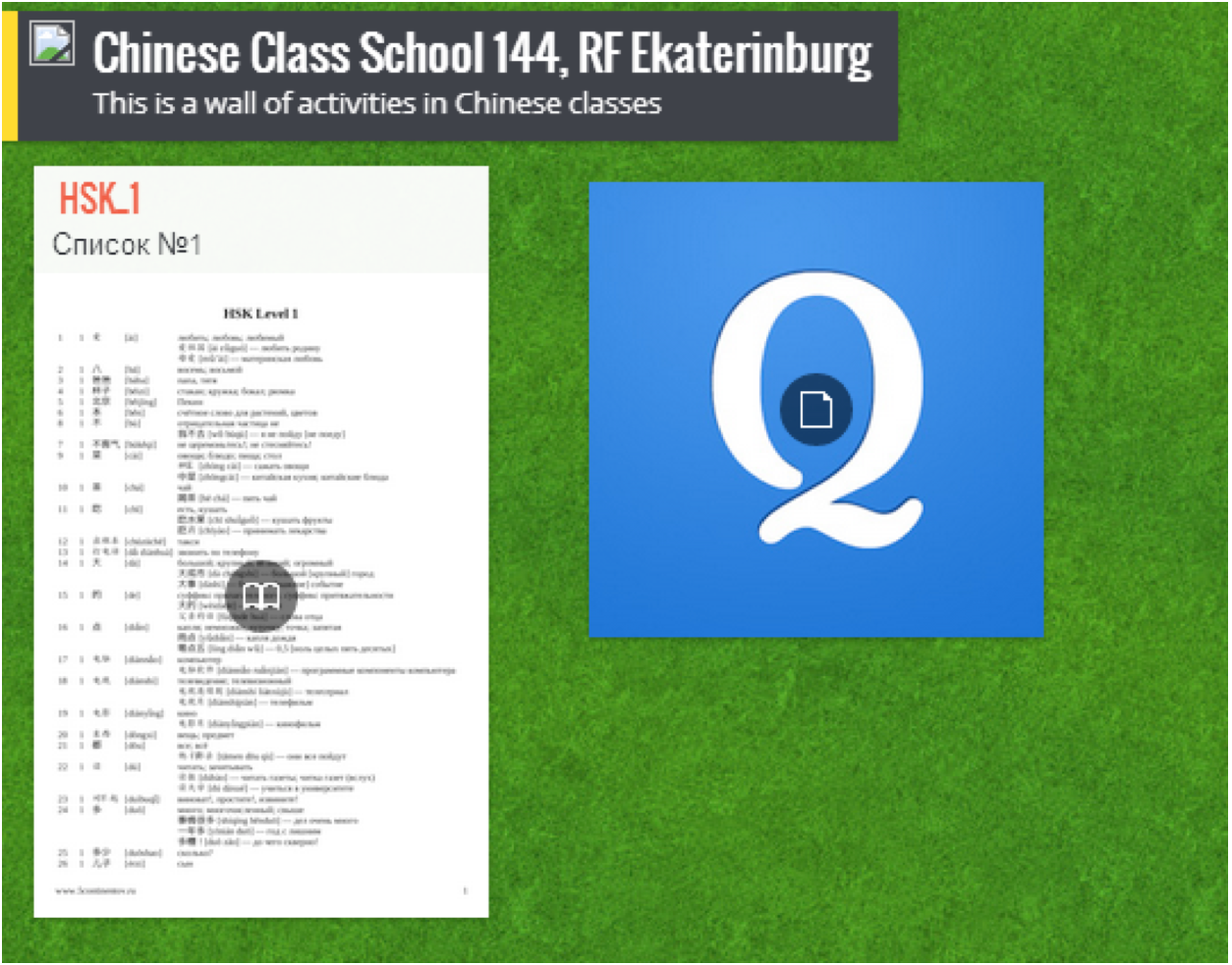
The initial enrollment to our class was unlimited and kids from all grades were accepted. Thus, the age range of students was enormously different, from 7 to 15 years of age. When the drop out of students reached a critical level of 50%, we decided to introduce more technology to class and substitute books for on-line resources. The participants of the experiment were 10 beginners with elementary level of Chinese at a public comprehensive school in Yekaterinburg, Russia. They were enrolled in 1 studying group during 2 semesters. Most of the participants were 14-16 years of age. At the moment of data collection they were at their final stage of a 6-month/4-hour-per-week introduction-to-Chinese elementary course. Each stage was delivered in both types of format: in-class learning and homework assignment. In class the students were doing the task under the supervision of the teacher. At home they were doing this task on their own and had to submit shortcuts from their home computers as the evidence of their home assignments’ completion. After doing the stage in class and at home the students were asked to answer the questions from the ‘Chinese learning questionnaire with number-coded answers’ and range their answers according to the attached scale.
1. The enhancement of interest in Chinese.
2. Intercultural competence development.
3. Exposure to everyday vocabulary in context: Chinese equivalents of such English phrases as ‘look at the board’, ‘follow me’, ‘press the button’.
4. Introduction to modern corpus linguistics’ concepts.
5. Science popularization.
6. The development of specific information technology skills: work with frequency lists, text annotation.
7. The actualization the feeling of achievement.
1. All cognition principle: students were exposed to audio on-line cards, listening and speaking to the teacher in class.
2. The focus on vocabulary learning, rather than grammar rules learning. The following idea, formulated by Fontecha et al. (2012), exemplifies the pivotal role of vocabulary learning for sustainable motivation, ‘vocabulary knowledge is central in FL learning. A large number of studies have shown a positive link between learners' achievement in FL learning and motivation. However not many have paid attention to the specific effect of motivation in FL vocabulary learning’.
3. The principle of equal opportunities and free education to everyone.
4. Reflective practices on task completion.
5. Flexibility and choice autonomy while implementing the task.
6. Meaningful tasks which can further develop information technology competences.
Upon the completion of each stage of the experiment the students had to provide answers to the following questionnaire. The questionnaire was adapted from the questionnaire used in Ma's (2009) and Mozgalina’s (2015) study, enriched with our own questions and translated into Russian. (table 1).
Table 1
Chinese learning questionnaire with number-coded answers
Completely disagree |
|
Completely agree |
||||
1 |
2 |
3 |
4 |
5 |
6 |
7 |
1. I did this task only because my teacher asked me to do it. I wouldn't have done this task on my own.
2. I did this task but I am not sure if it was worth it.
3. I did this task for my own good.
4. I think that this task is good for my knowledge of Chinese.
5. I don't know; I don't see what this task brought me.
6. If I had the opportunity, I would continue doing this task.
7. If I had a chance I wouldn't have finished the task. This task is something that I had to do.
8. I think that this task was very useful for my knowledge of Chinese.
9. This is a task that I could do very well.
10. I think that this task is practical and I can use its results in my everyday discussions in Chinese.
11. I believe that this task was important for me.
12. I felt good when doing this task.
13. I did this task, but I am not sure it was a good thing to pursue it.
14. I had some problems with doing this task in Chinese class.
15. I liked to study Chinese this way.
16. I fought with my parents about doing this task for my Chinese class.
17. I did other things (for example, watching a film or playing computer games) when my parents thought I studied Chinese.
18. It wasn’t hard for you to study Chinese this way.
19. I think I’ve learned Chinese too little while doing this task.
20. I think I’ve learned Chinese too much while doing this task.
21. I knew why the task was important for my progress in Chinese.
22. I can name some new skills which I’ve developed while doing this exercise in Chinese.
To sum up the main stages of our experiment we find it necessary to visualize its 3 stages (Figure3).
Figure 3
The 3 stages of the experiment
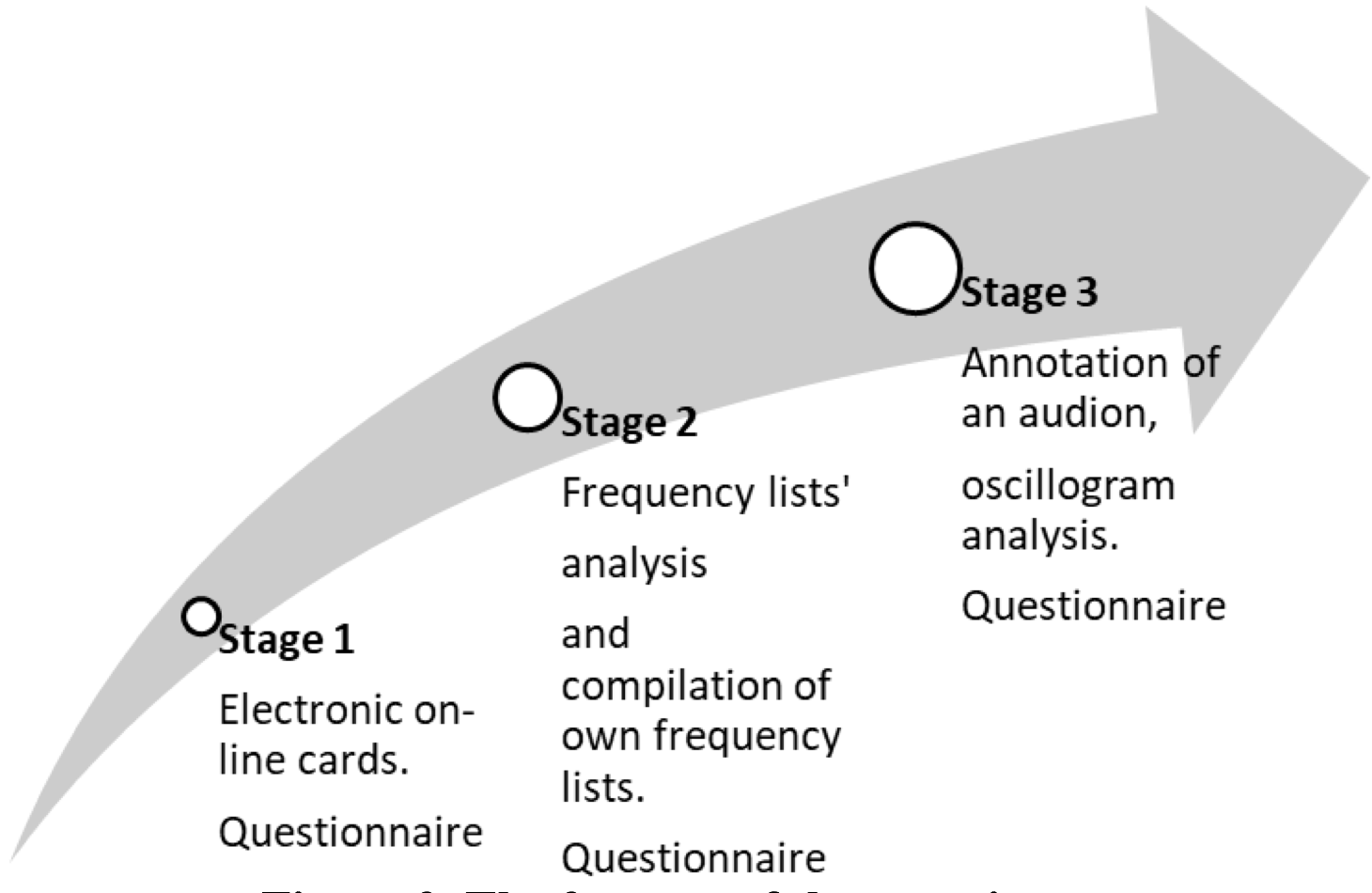
The students were given semantic explanation and exposure to new words and expressions with the help of the on-line electronic cards’ set from Quizlet.com (Quizlet, 2015).
This web tool makes it possible for students to listen to the audio with the pronunciation of both Chinese and Russian equivalents, generate an automatic on-line test and play 2 word games with the words from the cards. Yet, we consider this approach a perfect training tool but not a science tool.
Figure 4
The electronic on-line card set for stage 1
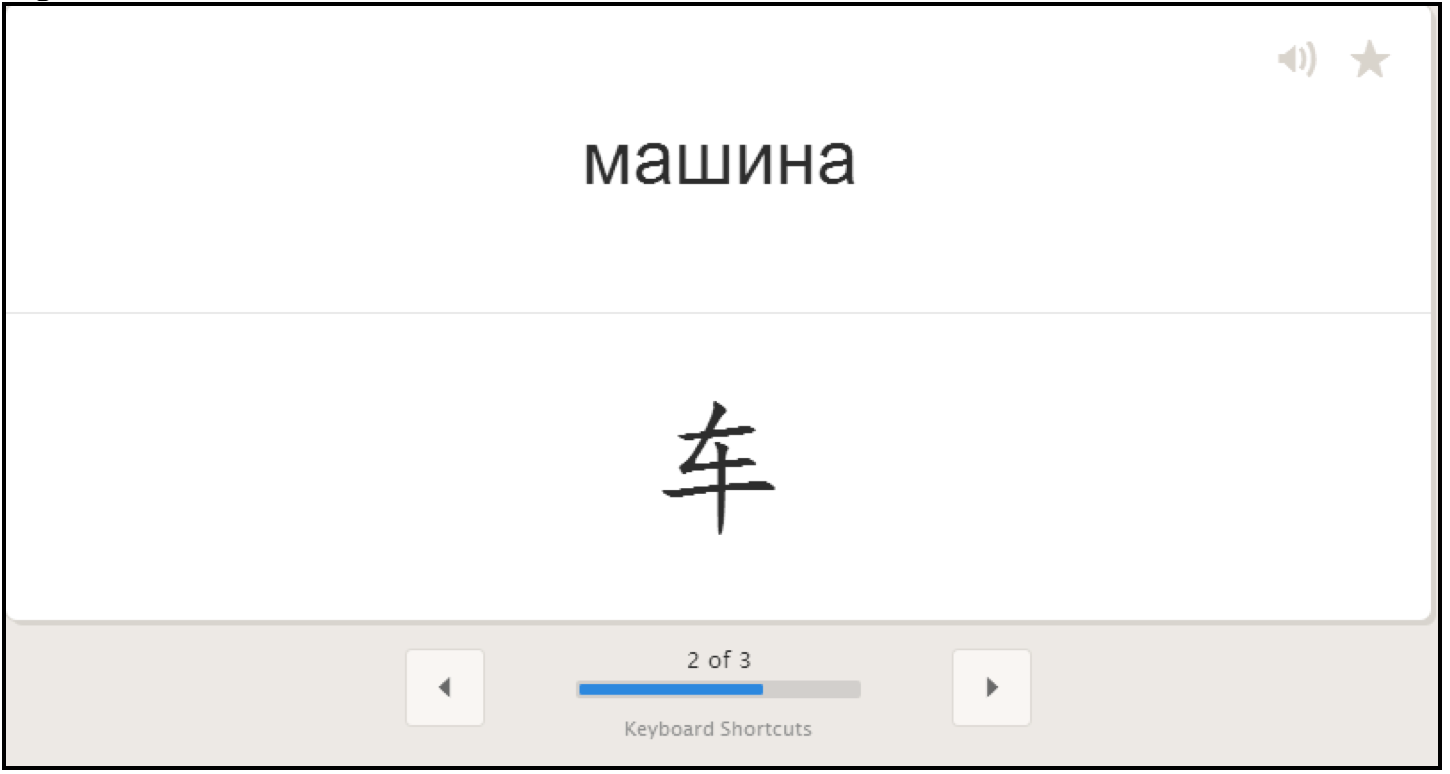
During this stage students were given a choice to choose the task: learning cards by heart, test mode or game playing. Learning autonomy is a key determinant in modern technologically advanced classroom, according to the theoretical study of V.Tudini (2015), ‘Guidelines derived from the theoretical exploration thus harness the potential for global connectivity and developing learner autonomy offered by communication technologies’. The students were given the task to repeat their experience with the on-line cards at home and answer the questions of ‘Chinese learning questionnaire with number-coded answers’ the next day in class.
The analysis of Chinese frequency lists and compiling students’ own lists. At this stage the students were asked to identify Chinese characters, they’ve learned at stage 1, and analyze their frequency (Figure5). The content of our lessons was significantly enriched with the results of data extraction from Chinese corpora (A collection of Chinese corpora and frequency list, 2015). Basic principles of the corpora are described in the paper by S.Sharoff (Sharoff, 2006). Having students scrutinized the frequencies of basic characters from stage 1, we asked students to compile their own frequency lists with long words (2-ingrams mainly), rather than single characters. This step is viewed as an adaption of academic tenets which makes it possible for young learners to enter the field of linguistic research. These new rules and routines of language study shape a modern vision of vocabulary system and provide the sense of prospective for further development of vocabulary building strategy. This approach becomes for instance manifest in the task of selection of Chinese characters while preparing for the language proficiency exam (HSK).
Figure 5
The frequencies in the Internet corpus for stage 2
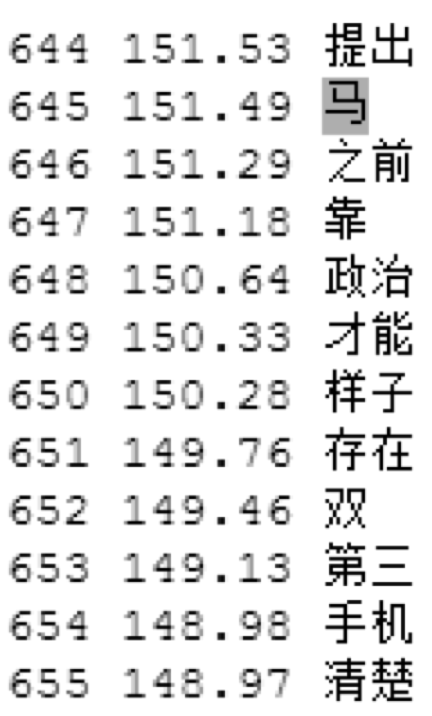
For their home assignment the students were given a new set of Chinese characters which they had to look up in the frequency list. The next time we met the students were asked to answer the questions about this task from ‘Chinese learning questionnaire with number-coded answers’.
This stage presents the summit point of our endeavor to introduce science methods to Chinese classes. From this point we proceeded to the annotation of an audio dialogue in Chinese.
Figure 6
The annotation of an audio passage

We started from a simple experiment with the oscillogram of 2 Chinese native speakers (Figure6). The language they used was simple and the students were asked to make very simple annotations to this passage. The excitement of the work proved to be very high and the students felt more like scientists in the laboratory than young learners. At this stage they needed a small vocabulary of the following Chinese words: ‘mama’ (mother), ‘che’(car), ‘zhe’(this), ‘bu’(no/not), ‘shi’ (to be), ‘wo’(I), ‘de’(the particle to show possession). The teacher’s role was to explain the mechanics of the program for the video and audio annotation ELAN 4.9.0., 2015, developed in Max Planck Institute for Psycholinguistics (Lausberg, H., & Sloetjes, H., 2009).The teacher had to introduce to students some small-scale operations which they were later asked to repeat individually. They’d been already taught how to print Chinese characters by that stage of the experiment. For their home assignment they had to annotate another audio piece and make a screenshot of home annotations. Next class they answered the questions about this task from ‘Chinese learning questionnaire with number-coded answers’.
The central contribution of this paper is the analysis of empirical material, collected through all the stages of our experiment. The analysis of the questionnaire answers made it possible to develop the following graphs.
Figure 7
The results of stage 1
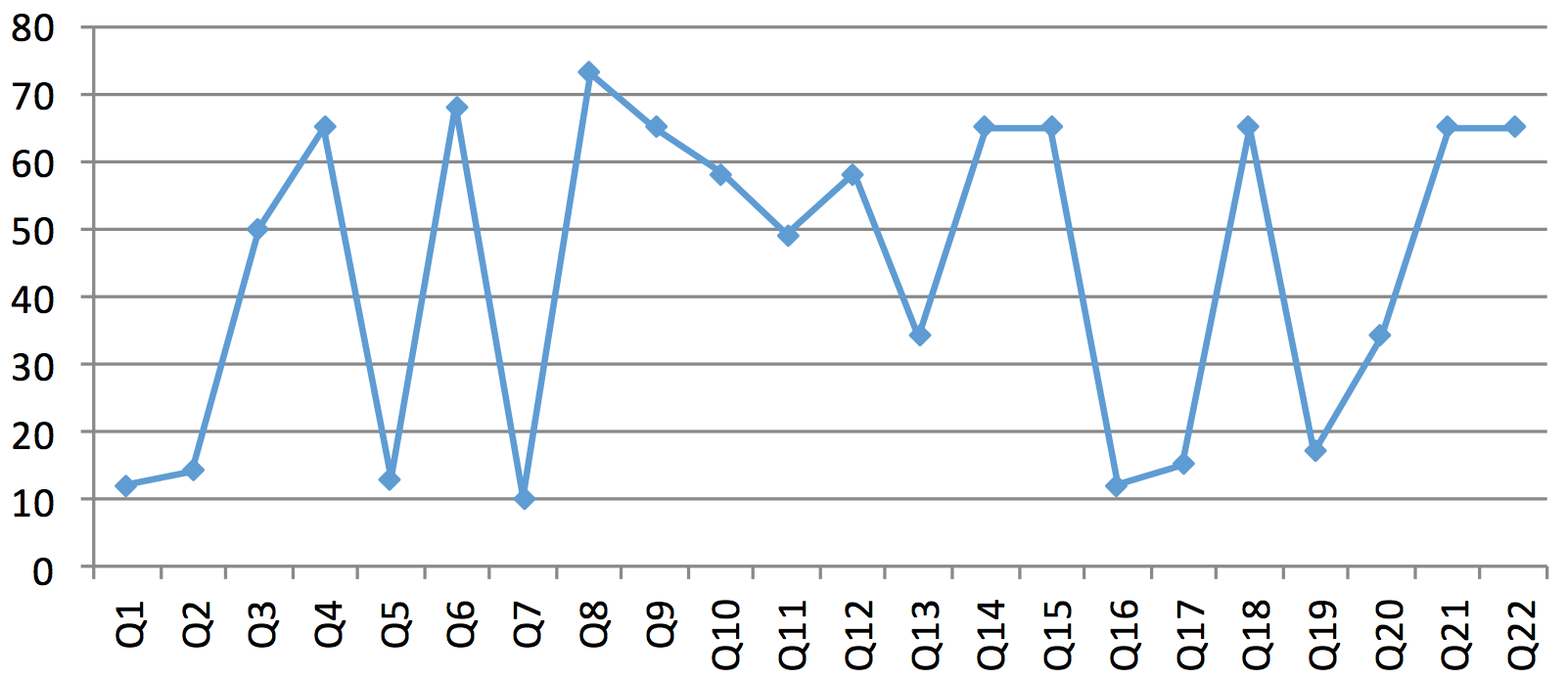
Figure 8
The results of stage 2
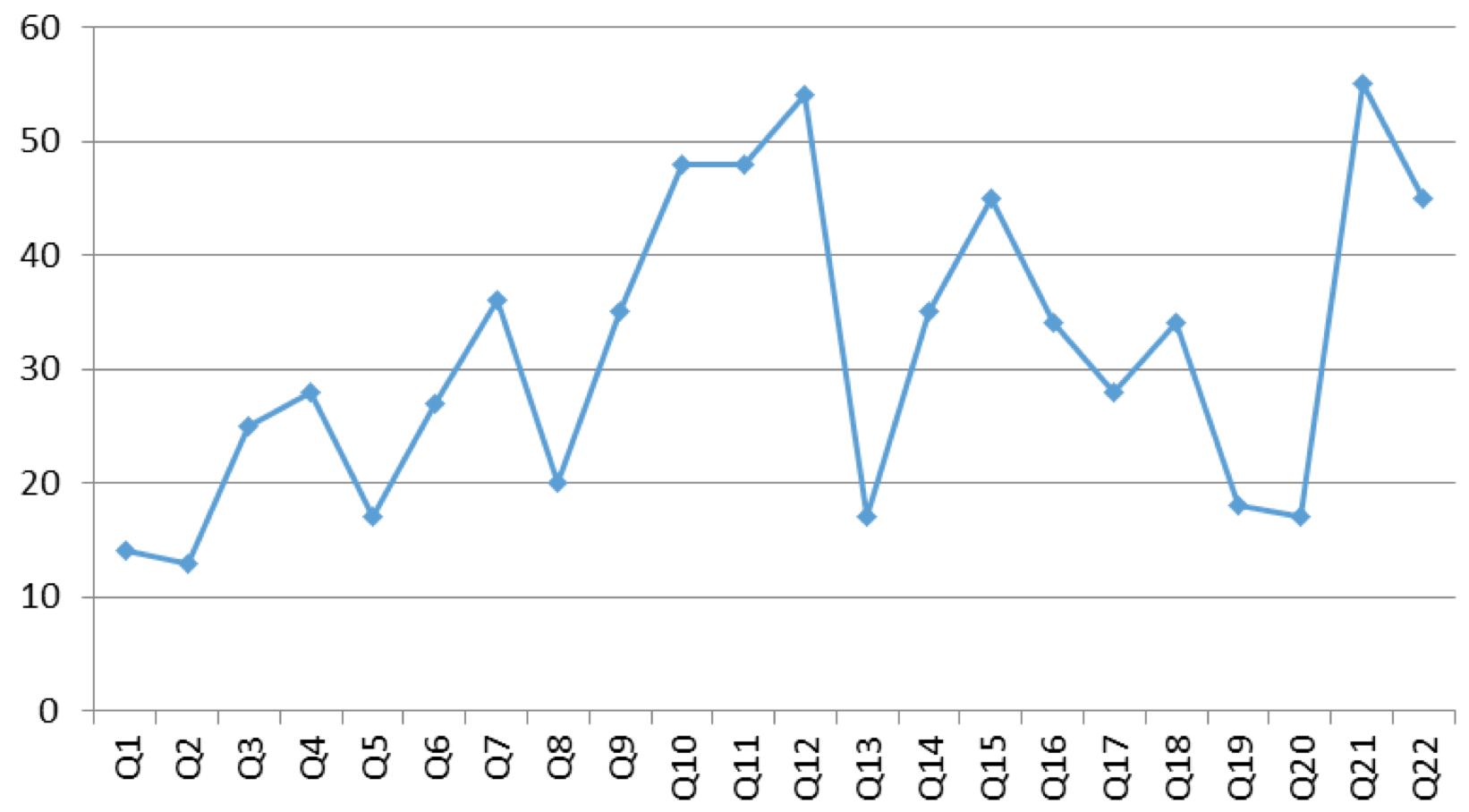
Figure 9
The results of stage 3
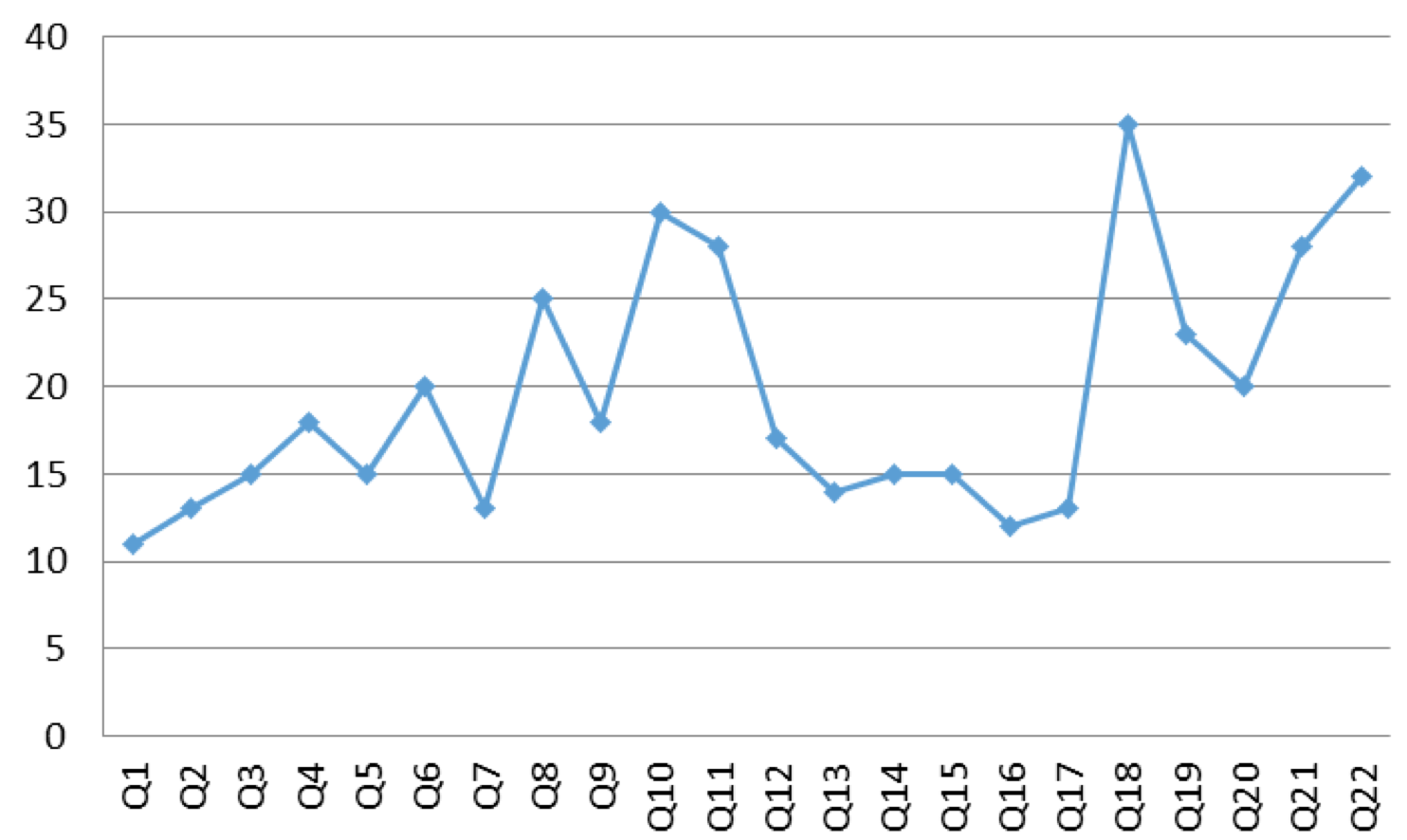
Since the second half of the XXth century the world has entered the stage of increased economic globalization, resulting in unprecedented world integration and the development of effective cheap mass communicative channels. Although, globally speaking, English is the main language of international communication; we are witnessing the growing importance of the Chinese language. This process is proactively bolstered by Chinese officials who claim the Chinese language to be the nation’s soft power. The role of the language in the establishment of China’s international reputation was even further developed in the ideas of Wang Yue-xin and Wang Gang (2008), ‘the strength of a particular language is the symbol of the state of that nation. … Language is not only the core of its “soft power”, but also an important part of its “hard power”.’ The central contribution of this paper is the idea that learning Chinese is a significant advantage for the receiving side (Yekaterinburg public comprehensive school), as well.
The educational aim of teaching Chinese in Russian schools falls in line with the objectives set in ‘Agreement on Cooperation in the Field of Culture’ (2015) by BRICS countries. The Agreement exemplifies that BRICS countries are ready to ‘develop cooperation on matters of common interest in the fields of traditional knowledge and cultural expressions’ (Ibid. p.3 Article 7). Knowledge of Chinese in Yekaterinburg is of vital importance because the city is at the crossroads between Europe and Asia. Yekaterinburg held the first BRIC Summit on 16 June 2009. Yekaterinburg is the place of the annual international industrial exhibition ‘Innoprom’, the international forum, which in 2015 was entirely dedicated to China and Russian-Chinese industrial cooperation.
The social aspect of teaching Chinese in Yekaterinburg is that all classes of Chinese are free. Thus, we view Chinese classes as an effective tool to combat injustice and inequity. We also faced some challenges of multicultural teaching for the teaching staff was sometimes mixed, 1 teacher from the Russian side and 1 teacher from the Chinese side.
The reasons for studying Chinese in Yekaterinburg are as follows:
1. The unprecedented growth of Chinese economy.
2. The explosive popularity of Chinese culture in Russia which may be accounted for our common communist past and modern market realities.
3. Russia’s membership in BRICS and SCO.
4. The geographical position of Yekaterinburg as a logistics hub between Europe and Asia.
On the international level the advances of studying Chinese as a foreign language are also evident in many countries. The study of American students, learning Chinese in China during 1 semester, conducted by H. Du (2015) exemplifies that ‘that some students' identification as Americans was strengthened during study abroad, data also indicate that students in this study took great pride in their Chinese proficiency, fully embraced their "foreigner identity," and used it to their advantage.’ Thus, we conclude that learning Chinese for Russian students may also become a great international experience. Besides obvious pluses of learning the most spoken Asian language, M.C. Bride believes that ‘learning Chinese may strengthen both segmental and suprasegmental phonological sensitivity and even promote basic visual skills, potential cognitive advantages’.
The results of our experiment’s findings show it that although stage 1, with relatively simple and clear card-based tasks, proved to be a more favorable activity for the majority of students, yet, the teenagers showed a steady interest in more challenging corpus-based and annotation tasks. This finding illustrates the idea that Russian students like to familiarize themselves with new technologies which promote new directions for their cognitive and meta-cognitive competences’ development. Such teaching approaches offer applicable, interdisciplinary and intercultural activities which integrate students into modern science communities. In group discussions students stressed the significance of tasks which incorporate insights from modern scientific initiatives. As one girl put it, ‘I liked to feel myself a laboratory genius, doing sound analyses’. Yet, some students (3 out of 10) remained indifferent to most of the tasks which they explained mostly on the grounds of their general indifference to computer-based tasks in particular and information technology in general. This entails that for further development we should adopt a blended model of teaching Chinese both as a pen-and-paper activity and on-line science-based learning .
Russia is integrating into world community which falls in line with the development of a harmonious global society. Modern education authorities place a significant emphasis on socio-cultural acquisition of Chinese heritage in Russia. This brings us to the point that teachers of Chinese have to find new inspiring directions for their students to follow. Our experiment made it clear that middle school students are aware of China’s increasing power on the world stage, so they pursue the path of learning Chinese at school level. The students are also attracted by modern technological innovations which offer a great variety of new interactive forms of language learning facilitations.
The results of our experiment are limited to the group of these particular students. However, we may assume that students in other learning groups may also adopt these practices. Further research should be conducted with different age groups and technological content. We hope that our highlights will contribute to learning Chinese in Russia and other countries.
The knowledge of Chinese has become exceedingly influential in the struggle for global markets both in China and abroad. Correspondingly, it can be anticipated that Russian markets are and will be in need of professionals with fluent Chinese. The role of teachers of Chinese should be seen as an instance of new philosophy building, resulting in global sustainable development.
A collection of Chinese corpora and frequency list. Date Views June, 6 2017 corpus.leeds.ac.uk/query-zh.html.
Agreement on Cooperation in the Field of Culture. Date Views June, 2 2017 en.brics2015.ru/documents/
Cai, S., and W. Zhu, 2012. The Impact of an Online Learning Community Project on University Chinese as a Foreign Language Students' Motivation. Foreign Language Annals, 45(3): 307-329.
Cheng, A., 2015. Teaching Chinese in the Global Context: Challenges and Strategies. European Review, 23(2): 297 - 308.
Chinese Class. Date Views May, 25 2015 ru.padlet.com/st_conference/bj5ije00la.
Du, H., 2015. American College Students Studying Abroad in China: Language, Identity, and Self-Presentation. Foreign Language Annals, 48(2): 250-266.
ELAN 4.9.0. Date Views July, 12 2015 tla.mpi.nl/tools/tla-tools/elan/.
Fedotova, M., 2015. Russian Sayings: It's All Chinese to Me. BRICS Business Magazine, 5(16). Date Views July, 12 2015 bricsmagazine.com/en/articles/russian-sayings-it-s-all-chinese-to-me.
Fontecha, F., and T. Gallego, 2012. The role of motivation and age in vocabulary knowledge. Vigo International Journal of Applied Linguistics, 9(1): 39-62.
Lausberg, H., and H. Sloetjes, 2009. Coding gestural behavior with the NEUROGES-ELAN system. Behavior Research Methods, Instruments, & Computers, 41(3), 841-849.
Ma, J. H., 2009. Autonomy, competence, and relatedness in L2 learners' task motivation: A self-determination theory perspective. University of Hawai'i at Manoa, 2009. Unpublished doctoral thesis. UMI 3380512.
McBride, C.A., 2016. Is Chinese Special? Four Aspects of Chinese Literacy Acquisition that Might Distinguish Learning Chinese from Learning Alphabetic Orthographies. Educational Psychology Review, 28(3): 523-549.
Mozgalina, A., 2015. More or less choice? The influence of choice on task motivation and task engagement, System, 49: 120-132
Panchenko, A., Romanov, P., Morozova, O., Naets, H., Philippovich, A., Romanov, A., Fairon, C. (2013) 35th European Conference on Information Retrieval: 837-840. Lecture Notes in Computer Science (including subseries Lecture Notes in Artificial Intelligence and Lecture Notes in Bioinformatics) (issue 7814), ECIR 2013; Moscow; Russian Federation; 24 March 2013 through 27 March 2013; Code 96205
Quezlet. Date Views July, 29 2015 quizlet.com/87620479/flashcards.
Ruan, Y., X. Duan and X. Du, 2015. Tasks and learner motivation in learning Chinese as a foreign language. Language, Culture and Curriculum, 28(2): 170-190.
Serelex search system, 2015. Date Views June, 29 2015 http://serelex.cental.be/?language=ru#china
Sharoff, S., 2006. Creating general-purpose corpora using automated search engine queries. In Marco Baroni and Silvia Bernardini, editors, WaCky! Working papers on the Web as Corpus. Gedit, Bologna. Date Views June, 2017 corpus.leeds.ac.uk/serge/publications/wacky-paper.pdf
TASS. Russian News Agency, 2015. Date Views July, 29 2015 tass.ru/obschestvo/2148586
Tudini, V., 2015. Interactivity in the teaching and learning of foreign languages: what it means for resourcing and delivery of online and blended programmes. Language Learning Journal: 1-16
Yue-xin, W., and W. Gang, 2008. Rational thinking of Chinese language teaching in the world. Journal of Hebei University, 33(4): 138–141.
Zavyalova, N., 2014. Narratives of Cultural Encounters Through Communicative Prism. European Journal of Science and Theology, 10(6): 163-174.
1. Ural Federal University (UrFU), 620002, Russian Federation, Ekaterinburg, Mira street, 19. E-mail: n.zavzav@yandex.ru